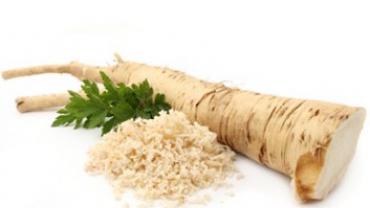
For Jewish people around the world the Passover Seder plate contains several foods that have symbolic importance but which also happen to be recognized for their health promoting benefits. Among these are charoset which is typically made with walnuts apples cinnamon and wine; a hard-boiled egg; a sprig of parsley; a lamb shank and more. Another potent food that makes an appearance on traditional Seder plates is horseradish. Horseradish may be best known for its stinging almost burning sensation on the tongue and for sure few things are better at opening one’s sinuses. But this root vegetable is good for far more than that.
Horseradish is a tough thick gnarly looking root believed to be native to southeastern Europe and western Asia. It belongs to the Brassicaceae botanical family a category that also includes other potent medicinal and culinary plants such as mustard and wasabi. (Wasabi is sometimes called “Japanese horseradish” although the two plants belong to different genus.) Other brassicas include broccoli Brussels sprouts cauliflower cabbage and kohlrabi. One of the many things these plants have in common is a high sulfur content which may be a primary contributor to some of the beneficial health effects these foods are known for.
Nutritionally speaking horseradish isn’t exactly something to write home about. Prepared horseradish root is a good source of vitamin C and has trace amounts of essential minerals. But few people turn to horseradish for its micronutrient content. (And even if they did they’d have to eat far more than a typical serving in order to reach any significant amount of minerals.) Typically it’s used as a garnish or a sauce classically paired with an elegant roast beef or even used in sandwiches with both preparations often calling for a horseradish cream sauce. Horseradish is also a key ingredient in the cocktail sauce served with cold shrimp. Store-bought versions are usually made with high-fructose corn syrup or sugar but there are plenty of Paleo-style cocktail sauce recipes that avoid these. Other delicious ways to introduce a little more horseradish at the table are Brussels sprouts with bacon-horseradish cream and baked potatoes with horseradish and caviar.
Fortunately the paltry nutrient content of horseradish is made up for by other good reasons to eat this root. It’s anti-inflammatory antimicrobial and anti-fungal and has been shown to provide antioxidant protection against hydrogen peroxide for human cells in vitro. In this regard horseradish is similar to garlic another sulfur-containing food that stings and burns when used raw and freshly crushed or grated.
Whole horseradish root has nearly no aroma. When cut or grated however enzymes from the crushed plant cells break down the sulfur-containing glucosinolate singrin resulting in allyl isothiocyanate (a.k.a. mustard oil) which is the compound responsible for irritating the mucosal membranes of the eyes and sinuses. This is another similarity between horseradish and garlic: an intact bulb of garlic has no aroma. Allicin one of garlic’s most potent compounds is activated via enzymes during crushing or chewing.
The potent aromatic and flavor compounds in horseradish are volatile. Upon exposure to air and heat they lose pungency darken in color and become unpleasantly bitter tasting. This is likely why most commercial horseradish preparations include vinegar in order to preserve these compounds as well as to modulate the degree of “hotness” in the final product. Vinegar stops the enzymatic action that develops the volatile compounds in freshly grated horseradish so for horseradish that’s milder it’s best to add vinegar immediately. For a hotter horseradish vinegar should be added after waiting a few minutes. The stinging compounds in fresh grated horseradish root may be so strong that home cooks are advised to attempt this only in a well-ventilated area and they may also want to wear gloves and avoid touching their eyes or nose. Touching one’s eyes after handling raw garlic would be no picnic either. These two sulfurous plants have quite a lot in common not the least of which are their health benefits and their contribution to simply making food taste great.